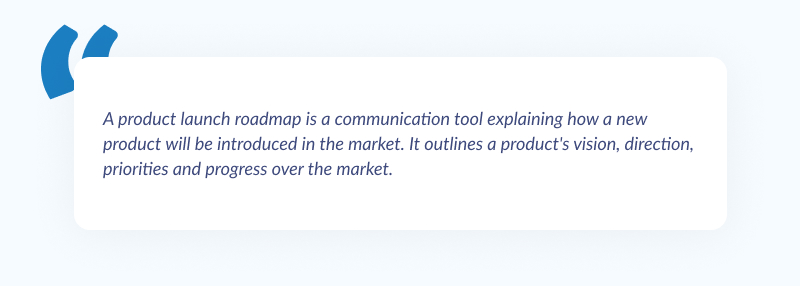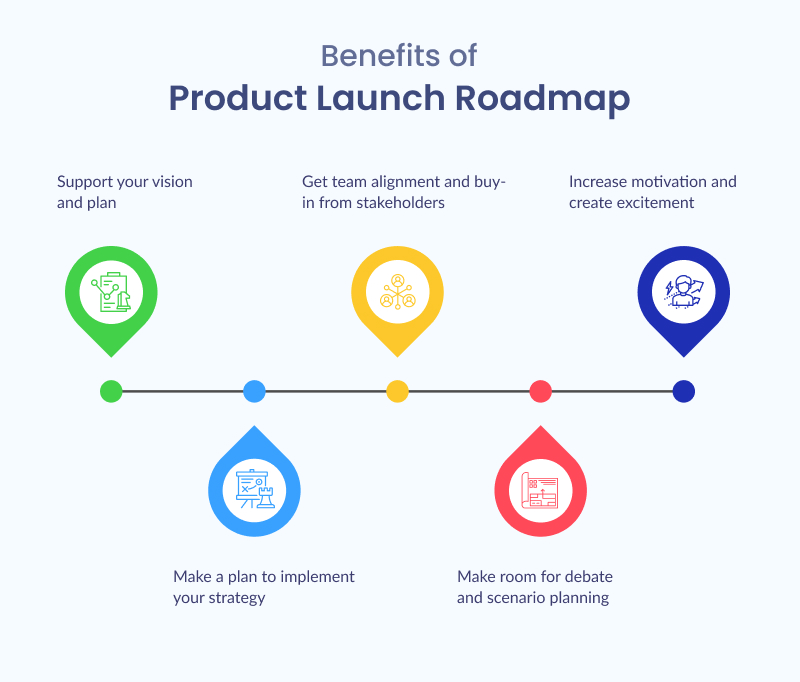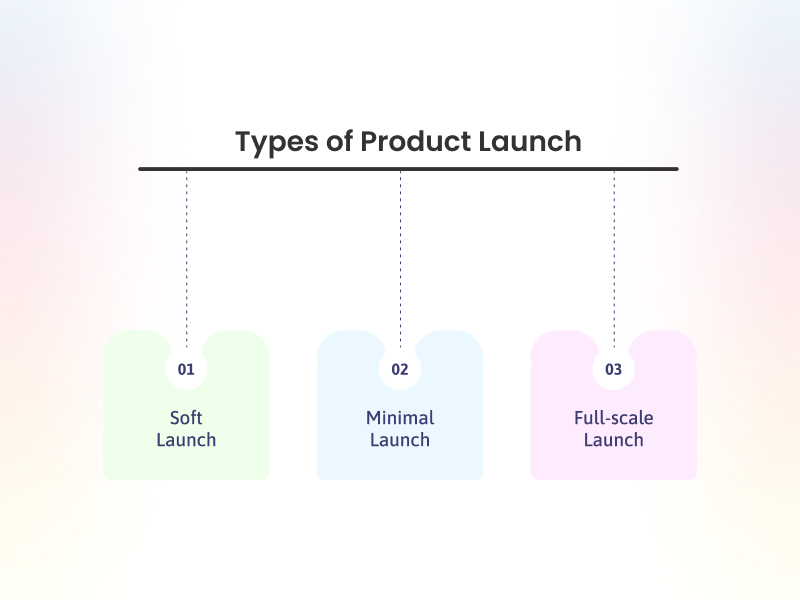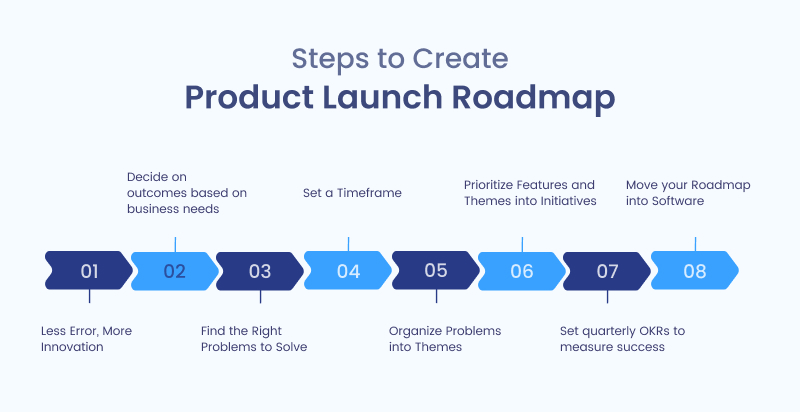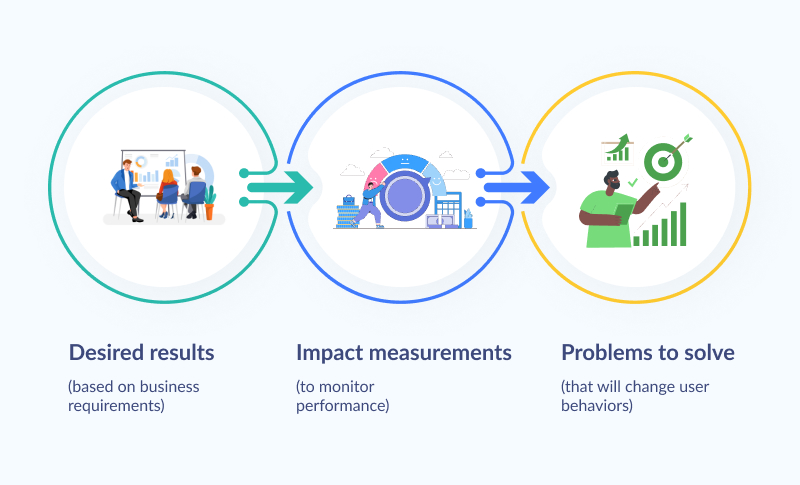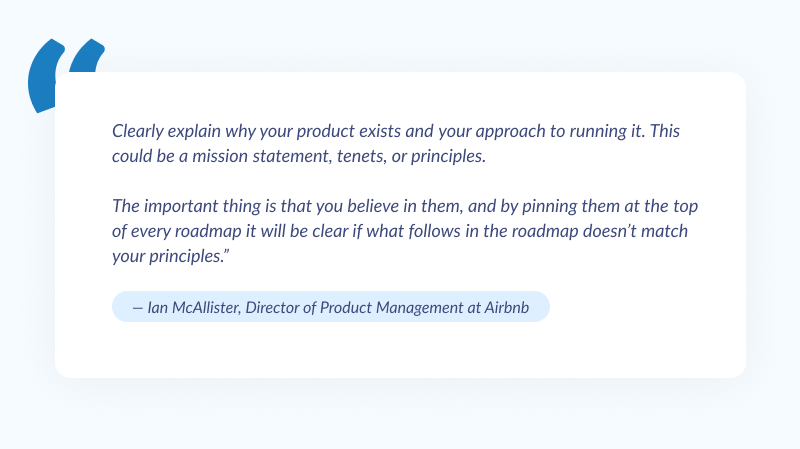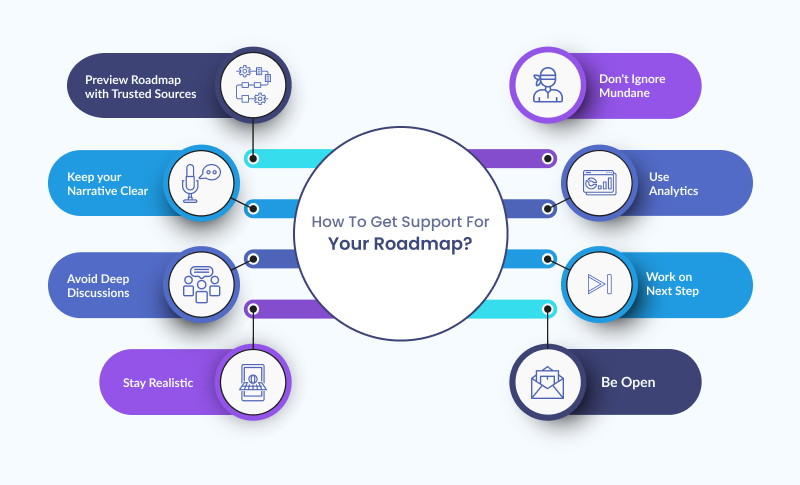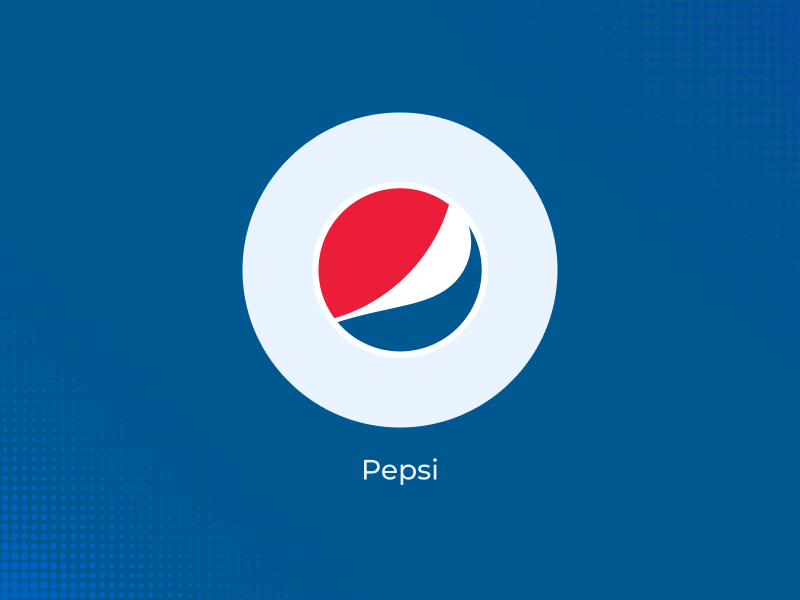The process of launching a product can be both tremendously thrilling and terrifying. According to Forbes Magazine, only 10% of new products make a profit, making it quite difficult to survive in the business world. Launching a product is not an easy process, but you can make it easier with the help of a product launch roadmap.
Creating a successful product launch needs preparation and collaboration from numerous company departments. With the help of a roadmap, you can create a step-by-step guide for your team to follow.
This article will help you to understand the product launch roadmap, its advantages, points to consider before starting and a guide to creating a roadmap for your product.
Let’s begin with the objectives of the product launch roadmap.
Table of Contents
Product Launch Roadmap: Tool’s Objectives
The objective of product launch is to ensure that your firm, your partners, and your target customers are aware of your new product. If you don’t execute the product launch well, clients might not be aware of your solution or might think poorly of it, which could prevent you from achieving your revenue and profitability targets.
Further, a successful product launch can greatly impact a business. Here are a few points describing the same:
- Increases market recognition, income and anticipation for the product
- Offers early adopter feedback that the product team can use to enhance the product
- Facilitates planning and collaboration from numerous company departments
- Assists in complicated and strategic tasks
Let’s check out the main reasons for creating a product launch roadmap.
Also, Read – Top 11 Customer Journey Mapping Tools to get user insights
Why Do You Need A Roadmap For Your Product Launch?
Roadmaps are effective instruments for communication. There are multiple benefits of creating product roadmaps which are:
- Support your vision and plan: Roadmaps are primarily tools for communication. They are the only reliable source for information on the goals and vision of your product.
- Make a plan of action to implement your strategy: Roadmaps are comprehensive but keep their level of information accessible to all. They make the important tasks necessary to achieve your goals visibility without getting lost in the details.
- Get team alignment and buy-in from stakeholders: The amount of visibility from the roadmap encourages trust and confidence in your plan from top to bottom of your business.
- Make room for debate and scenario planning: A roadmap is a dialogue rather than a command. Before you start burning up resources and time, they give everyone the chance to pose questions, express concerns, and offer input.
- Increase motivation and create excitement: Teams that have a common goal and are aware of their organization’s objective are more effective and successful. A roadmap is one of the most crucial tools for getting everyone on the same page and motivated for the future.
Types & Sizes of Product Launch
Product launches are of different types and sizes. You can decide which type of product launch is best for you to start your product launch roadmap. Some of them are as follows:
Soft Launch
A soft launch is when your product quietly enters the market. Products that are sold from one business to another sometimes begin this way. You may not draw much notice, but if your product isn’t quite ready for prime time, it makes more sense for a small number of customers to look at it at once.
Minimal Launch
The minimal launch is a cost-effective way to spread the news about small items or minor iterative product updates.
Full-scale Launch
Aim for a full-scale launch to spread the word about your product to your target market. You’ll have to put a lot of time and effort into accomplishing this. It also has the best possibility of succeeding.
Steps To Create A Successful Product Launch Roadmap
A successful product launch needs preparation and collaboration across many company departments. You should utilize a strategic roadmap to create your product launch plan to make your launch journey appear seamless.
Here are some pointers and techniques for creating a successful product launch roadmap.
Step 1: Research and Context Building
Product roadmaps are useful for two things. First, they convey your priorities and goals. Second, they develop support for your plan across the organization.
Consider your roadmap’s audience before anything else. The internal roadmap created by your technical team will emphasize different components than one intended for executives. Who is viewing this object, and what are they hoping to see? A specific target audience can help when you finally offer your roadmap. Consider your company’s current situation after that.
Product roadmaps develop and alter along with the expansion of your business. A startup creating an MVP has a very different product roadmap than a more established business juggling numerous products in various markets.
Ensure you’re in the appropriate frame of mind before considering outcomes, features, or priorities.
Step 2: Decide On Outcomes Based On Business Needs
Product roadmaps are outcome-driven planning tools for agile teams. This indicates that they concentrate on the change you wish to bring about to advance your entire plan. Your built-in features or goods serve only as a tool.
To begin your journey, first consider your business needs. What is the desired outcome of your roadmap and why does it matter? In order to identify areas of impact, revisit your strategy and goal.
Additionally, you can explore your other resources, such as market research, competition analysis, internal stakeholders requests, users outside the company, or even existing tasks in your backlog.
Further, collaborate with coworkers and important stakeholders to come up with the following vital components:
- Desired Outcome: What is the business requirement you are attempting to address? For example, to become the top retailer of Samsung mobile cases in North America.
- Impact Metrics: What impact measures show that a problem is being solved as effectively as possible? For instance, increase revenue by 15% or make 3 items the typical order amount for a customer.
- Behaviour Change: What user habits must alter to achieve your goals? You could increase revenue by concentrating on top-of-funnel consumers, upselling to current customers, or even reactivating churned clients.
These elements give your roadmap a narrative that will move from strategic to tactical.
Step 3: Find The Right Problems To Solve
It’s time to consider how your product is currently being used and how you may influence user behaviour to move closer to the goal. This is what we like to call “fixing the problems.” There are various places to identify problems to connect to your desired outcomes:
- Customer Feedback: User interviews are the greatest method for identifying user issues. Look for input from sales, marketing, customer service, and other user-facing departments if you cannot speak with customers directly or want more data sources.
- Product Backlog: You’ve probably already listed all the tasks, challenges, and difficulties you need to solve. Check each one to see if it still fits in with your overall product strategy, provides value, and has an owner.
- Usage: Customers don’t always express their desires to you. Instead, focus on how customers use your product to identify any issues, challenges, or points of friction that you might be able to resolve.
- Market and Competitor Analysis: You want your product to be a leader. However, it’s still important to observe the issues your rivals are resolving or the direction in the market is evolving.
Spend some time thoroughly examining your problem discovery. A successful roadmap starts with identifying the problems you need to solve to advance toward your goal.
Step 4: Set a Timeframe
Set a broad yet reasonable timeframe based on your desired outcome and the issues you’ve discovered.
Do these issues have apparent quick fixes that you can test in a few months? Or do you intend to make substantial strategic changes that could take years to implement? Any transformation requires time.
However, a product roadmap should indicate progress as soon as possible to prevent you from committing to spending years chasing after ineffective results.
Step 5: Organize Problems into Themes
You should now have a reverse funnel leading from a specified intended outcome to a small number of impact metrics and then a long list of issues to address (and probably some existing backlog items that fit).
There will be some mess, but it’s crucial to see this progression from objective to potential resolution (and see how many different paths lead to the same outcome).
You shouldn’t commit to a single solution just yet. It’s a mistake to have tunnel vision when creating a product roadmap because product work combines experience, data, and intuition.
Instead, look at your list of issues and find patterns that connect them.
Step 6: Prioritize Features and Themes Into Initiatives
Roadmaps are a method for setting priorities. You can choose from a number of routes to get where you want to go. However, you have to choose which one you want to take.
There are some common exercises you can use to get started:
- Possibilities, appeal, and viability: Examine features to determine whether they are desirable to customers, technically feasible, and support your overall product plan (viability).
- Cost and Impact Scales: With this basic 2×2 grid, you can score features according to the amount of impact they will have, given the work they require. Finding high-impact, low-effort/cost features is the aim.
- The RICE approach: This approach goes a little further by rating a feature on a few different criteria. How many individuals will it affect initially and for how long? On a scale of 1-3, how much will it influence your strategy and objectives? On a scale of 1 to 100, how certain are you that it will be a success?
Step 7: Set Quarterly Okrs To Measure Success
It’s time to arrange the themes and related elements. Each milestone or release on a solid product roadmap paves the way for the next. As an agile team, it is ok to make long-term assumptions to base your roadmap.
Most product roadmaps fail as they move from high-level objectives and prioritized features to daily chores. However, the main objective of any roadmap is to ensure that your present actions are consistent with your desired future state.
The greatest way to keep your daily job list connected to your overall product plan is by using Outcomes and Key Results (OKRs). OKR is a goal-setting strategy consisting of:
- Outcome: This is the result you’re going for. For instance, this can involve finishing a feature or moving closer to the goal you have in mind.
- Key Results: This is how you’ll gauge the effectiveness of your efforts.
An OKR serves as a waypoint on your journey that indicates your location and the amount of progress you’ve made. OKRs are great for setting quarterly goals for your product roadmap and having the means to evaluate and rate their success. Then, you construct what occurred and modify your roadmap accordingly.
The Q1 will influence your Q2 roadmap and so forth. By doing this, your roadmap will constantly evolve and change in response to your actions rather than remaining a static document.
Step 8: Move Your Roadmap Into Software
You now have all you need to present your product strategy and gain support. Let’s take a step further.
With the help of roadmaps, you can build trust with your development team. But only if everyone has access to them can this occur.
For instance, you might put your sprint tasks into a straightforward Kanban board to give everyone a high-level picture of what is being worked on and how it links to your overall roadmap. It is crucial to validate issues and requests before adding tasks to your project management software.
Step 9: Review And Align Roadmap With the Internal Team
A product roadmap takes extensive research, thought, and compromise. You must also strike a balance between the needs of your organization.
Collaborate with other teams and stakeholders in the process to get their feedback. Ask questions about:
- Which issues do you believe need attention the most?
- Why do you think it is required?
- What industry trends should you look into?
- What do you believe will occur if we don’t implement this suggestion or create this feature?
Keep conversations brief and focused and try to hold conversations regularly with your team. Keep in mind that roadmap alignment is a continuous process.
How To Get Support For Your Roadmap?
Roadmaps need support from leadership and the development team. But this is where things become complicated as every group has different requirements. Leadership wants to concentrate on the demands of the company and how its strategy will affect its long-term objectives. Development teams are interested in your commitments to them, if they are reasonable, and how they will fit into their present workload.
Here are a few recommendations for explaining your product roadmap and garnering support across the organization.
Preview Roadmap with Trusted Sources
The success of your roadmap presentation depends on your audience. Be aware of your audience and the information they need to hear. Get a few reliable people to review your presentation and ask any questions you might have missed.
Keep your Narrative Clear
The ability to tell a story is crucial for product management. Use the research you started with to create a clear narrative. What results do you hope to achieve? How did you come up with the issues to address and the features and jobs to prioritize in order to address them?
Provide every piece of information that will assist you in developing your business case and get everyone on the same page, including context, anecdotes, and inspiration.
Avoid Deep Discussions
Presentations go off the tracks when you dive into them deeply. Do not get bogged down in specific features before demonstrating the necessity and advantages.
Keep your discussions high-level and leave the specifics of task management to your project management tool for your project plan or sprint planning.
Stay Realistic
Your presentation must demonstrate that you are aware of and grateful for the time spent by your development team.
Your development team will be rolling their eyes if a feature is still on the plan, even though it lacks a solid justification. You may frequently be forced to use a justification that concludes, “Management wants it.” But take the time to articulate and support it.
Don’t Ignore Mundane Tasks
The goal of development teams is to provide novel and intriguing features. However, roadmaps must balance cutting-edge new features and the necessities that keep your product operating successfully.
Use Analytics
Whenever feasible, support your decisions with facts and research. If you found user problems through analyzing user data, work on it.
Work on Next Step
Briefly describe what lies ahead once your MVP or V1 is released. This could refer to your launch strategy, QA/testing plan, or even your continual improvement approach. Keep your audience intrigued with your vision of the future.
Be Open
Estimates are a necessary component of product management, and pretending to be an expert is a mistake. Indicate the areas where you need additional user research or experiments to validate concepts and modify your roadmap.
Best Practices For Regular Updation Of Roadmap
We’ve all discovered dated planning documents that have been forgotten for a long time. So as a final reminder, keep in mind that a product roadmap is only useful if it is current and usable.
Once you are done with your roadmap strategy, follow the below points to keep it updated:
- Set a weekly time for updates: It does not have to take hours to complete. Just write notes and suggest changes to the roadmap based on what you’ve learned over the last week.
- Pay attention to your sales and marketing personnel: Typically, customer-facing personnel are the first to notice changes in customer behaviour. Instead of eliminating them from your customer journey mapping and corporate growth objectives, work alongside them.
- Reevaluate and downrank features frequently: Not everything included on a roadmap must remain there. Instead of focusing on what you can construct, consider what you can remove to address user issues.
- Connect with your customers: Take surveys to ensure your roadmap is up to date. You can ask app-related questions and regular surveys about what features they like or dislike.
- Keep a record of who’s checking your roadmap: Roadmaps are used by various audiences for various reasons. Executives might use it to acquire key resources, and salespeople might use it to try to close bigger agreements with customers. Make sure you understand who is using it and why so that you can make the necessary updates.
Successful Product Launch RoadMap Examples
Product Launch roadmap is important for brands as they mostly have just one chance to get things right. They require the appropriate launch plan, marketing materials, advertising assets, and more. A new product introduction necessitates the creation of fresh packaging graphics.
Here are a few product launch stories that will undoubtedly serve as inspiration for your next release.
Evolve by PepsiCo
A new design has been given to PepsiCo’s plant-based protein beverage. They used their in-house design team to create new packaging designs for their reformulated EVOLVE drink, which is being released in new flavours.
The new packaging’s design reflects the new flavours and draws inspiration from the outdoors. The Big Bend National Park, the Glacier National Park, the Haleakala National Park in Hawaii, and the Rocky Mountain National Park have all been highlighted in the new design by PepsiCo. The brand’s dedication to protecting the National Parks is demonstrated through the new design.
It was a terrific idea to demonstrate concerns for the environment and highlight a region’s natural heritage. Packaging your products sustainably is a terrific demonstration of your commitment to sustainable manufacturing.
WePay
In the marketing of new product launches, taking on the competition is nothing new. Consider the rivalries between Apple, Samsung, and Sony.
WePay recognized an opportunity to one-up PayPal when the company’s member account freezing practice garnered some unfavourable media attention. WePay appeared at PayPal’s annual developer conference and dumped a big block of ice filled with frozen cash and a straightforward message for PayPal users:
PayPal freezes your account.
It wanted people to know that its consumers wouldn’t experience the same situation. And it succeeded. The experiment was featured on the first page of TechCrunch and other well-known tech websites an hour and a half after the ice arrived. The publicity brought about:
- The stunt landing page had a 3x increase in conversions
- 300% more people signed up, with a 225% increase in traffic
- Not bad for a young company with little money for marketing
Absolut Juice
The brand-new Absolut Juice was developed in collaboration with Lizzo. It contained a blend of Absolut Vodka and natural juice. The Absolut website offers a broad variety of cocktail recipes you can make using their new product. It comes in Apple and Strawberry flavours.
Lizzo’s “Get Juicy” commercial got a lot of attention. The commercial emphasized how the centrepiece of a summer gathering can be seasonal delicacies. The commercial also honours the artist’s debut single release. The product and the song “Juice” go together perfectly.
In this case, Absolut aids a budding musician by marketing her new song in addition to a new product. Lizzo’s Juice reached some of the top charts around the world.
When you launch a new product, try to find someone who will profit from your product’s promotion.
Tommee Tippee
Tommee Tippee used a unifying issue and turned it into a publicity stunt to gain momentum for a campaign that wanted to inspire mothers to follow their paternal instincts. That would be the frequently pointless, unwanted parenting advice given by others.
As a method for mothers to figuratively wipe their bums with other people’s wisdom, Tommee Tippee converted parenting how-to books into limited-edition baby wipes. By doing this, it produced a usable product that served its primary objective: increasing brand awareness. As the brand attempted to break into the U.S. market, the launch assisted in raising awareness of both the brand and its #ParentOn slogan.
Unsplash
Unsplash announced a Kickstarter effort for a book with motivational images and essays from creators as a way to thank photographers who had contributed photos to assist the site reach 50 million downloads. The campaign’s objective was to raise $75,000, but they were able to raise $25,000 more. How? by enlisting influencers in the effort.
The book’s content was carefully chosen to include important figures from the creative sector, and as a result of their impact, the book reached new heights.
Wrapping up
The market entry of a new product is a difficult and uncertain process and you must have a strategic plan to launch your product.
You may achieve reasonable goals with your product launch by knowing your audience, establishing clear objectives, creating a marketing plan, acting before launch and coordinating your internal staff with the goals.
All in all, the product roadmap must be adaptable, with one foot firmly in the present and one eye on the future.
However, you can take the help of IT & marketing professionals like PixelCrayons. Our dedicated development team will assist you in providing a foolproof roadmap as per your business requirements.


